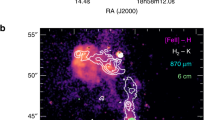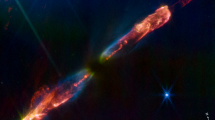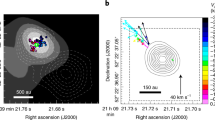Abstract
Planetary nebulae often have asymmetric shapes, even though their progenitor stars were symmetric; this structure could be the result of collimated jets from the evolved stars before they enter the planetary nebula phase1,2,3. Theoretical models have shown that magnetic fields could be the dominant source of jet-collimation in evolved stars4,5, just as these fields are thought to collimate outflows in other astrophysical sources, such as active galactic nuclei6,7,8,9 and proto-stars10,11. But hitherto there have been no direct observations of both the magnetic field direction and strength in any collimated jet. Here we report measurements of the polarization of water vapour masers that trace the precessing jet emanating from the asymptotic giant branch star W43A (at a distance of 2.6 kpc from the Sun), which is undergoing rapid evolution into a planetary nebula2,12. The masers occur in two clusters at opposing tips of the jets, ∼1,000 au from the star. We conclude from the data that the magnetic field is indeed collimating the jet.
This is a preview of subscription content, access via your institution
Access options
Subscribe to this journal
Receive 51 print issues and online access
$199.00 per year
only $3.90 per issue
Buy this article
- Purchase on Springer Link
- Instant access to full article PDF
Prices may be subject to local taxes which are calculated during checkout


Similar content being viewed by others
References
Sahai, R. & Trager, J. T. Multipolar bubbles and jets in low-excitation planetary nebulae: toward a new understanding of the formation and shaping of planetary nebulae. Astron. J. 116, 1357–1366 (1998)
Imai, H., Obara, K., Diamond, P. J., Omodaka, T. & Sasao, T. A collimated jet of molecular gas from a star on the asymptotic giant branch. Nature 417, 829–831 (2002)
Miranda, L. F., Gómez, Y., Anglada, G. & Torrelles, J. M. Water-maser emission from a planetary nebula with a magnetized torus. Nature 414, 284–286 (2001)
Blackman, E. G., Frank, A., Markiel, J. A., Thomas, J. H. & Van Horn, H. M. Dynamos in asymptotic-giant-branch stars as the origin of magnetic fields shaping planetary nebulae. Nature 409, 485–487 (2001)
García-Segura, G., López, J. A. & Franco, J. Magnetically driven winds from post-asymptotic giant branch stars: solutions for high-speed winds and extreme collimation. Astrophys. J. 618, 919–925 (2005)
Pearson, T. J. & Readhead, A. C. S. The milliarcsecond structure of a complete sample of radio sources. II—First-epoch maps at 5 GHz. Astrophys. J. 328, 114–142 (1988)
Blandford, R. D. & Payne, D. G. Hydromagnetic flows from accretion discs and the production of radio jets. Mon. Not. R. Astron. Soc. 199, 883–903 (1982)
Xu, C., Livio, M. & Baum, S. Radio-loud and radio-quiet Active Galactic Nuclei. Astron. J. 118, 1169–1176 (1999)
Gabuzda, D. C., Murray, É. & Cronin, P. Helical magnetic fields associated with the relativistic jets of four BL Lac objects. Mon. Not. R. Astron. Soc. 351, L89–L93 (2004)
Ouyed, R., Pudritz, R. E. & Stone, J. M. Episodic jets from black holes and protostars. Nature 385, 409–414 (1997)
Zinnecker, H., McCaughrean, M. J. & Rayner, J. T. A symmetrically pulsed jet of gas from an invisible protostar in Orion. Nature 394, 862–865 (1998)
Diamond, P. J., Norris, R. P., Rowland, P. R., Booth, R. S. & Nyman, L.-A. The circumstellar envelopes around OH/IR stars. Mon. Not. R. Astron. Soc. 212, 1–21 (1985)
Vlemmings, W. H. T., Diamond, P. J., van Langevelde, H. J. & Torrelles, J. M. The magnetic field in the star-forming region Cepheus A from H2O maser polarization observations. Astron. Astrophys. (in the press); preprint at http://arxiv.org/astro-ph/0510452 (2005)
Vlemmings, W. H. T., Diamond, P. J. & van Langevelde, H. J. Circular polarization of water masers in the circumstellar envelopes of late type stars. Astron. Astrophys. 394, 589–602 (2002)
Vlemmings, W. H. T., van Langevelde, H. J. & Diamond, P. J. The magnetic field around late-type stars revealed by the circumstellar H2O masers. Astron. Astrophys. 434, 1029–1038 (2005)
Nedoluha, G. E. & Watson, W. D. The Zeeman effect in astrophysical water masers and the observation of strong magnetic fields in regions of star formation. Astrophys. J. 384, 185–196 (1992)
Goldreich, P., Keeley, D. A. & Kwan, J. Y. Astrophysical masers. II. Polarization properties. Astrophys. J. 179, 111–134 (1973)
Kemball, A. J. & Diamond, P. J. Imaging the magnetic field in the atmosphere of TX Cam. Astrophys. J. 481, L111–L114 (1997)
Elitzur, M. Astronomical Masers (Kluwer Academic, Dordrecht, 1992)
Crutcher, R. M. Magnetic fields in molecular clouds: observations confront theory. Astrophys. J. 520, 706–713 (1999)
Elitzur, M., Hollenbach, D. J. & McKee, C. F. Planar H2O masers in star-forming regions. Astrophys. J. 394, 221–227 (1992)
Reid, M. J. et al. Stellar OH masers and magnetic fields—VLBI observations of U Orionis and IRC +10420. Astrophys. J. 227, L89–L92 (1979)
Chevalier, R. A. & Luo, D. Magnetic shaping of planetary nebulae and other stellar wind bubbles. Astrophys. J. 421, 225–235 (1994)
García-Segura, G., Langer, N., Rózuczka, M. & Franco, J. Shaping bipolar and elliptical planetary nebulae: effects of stellar rotation, photoionization heating, and magnetic fields. Astrophys. J. 517, 767–781 (1999)
Sahai, R. Bipolar and multipolar jets in protoplanetary and planetary nebulae. Rev. Mex. Astron. Astrofis. 13, 133–138 (2002)
Blackman, E. G. in Asymmetrical Planetary Nebulae III: Winds, Structure and the Thunderbird (eds Meixner, M., Kastner, J. H., Balick, B. & Soker, N.) 401–407 (ASP Conference Series Vol. 313, Astronomical Society of the Pacific, San Francisco, 2004)
Imai, H., Nakashima, J., Diamond, P. J., Miyazaki, A. & Deguchi, S. A biconically expanding flow in W43A traced by SiO maser emission. Astrophys. J. 622, L125–L128 (2005)
Lery, T. et al. Magnetised protostellar bipolar outflows. I. Self-similar model with Poynting flux. Astron. Astrophys. 350, 254–274 (1999)
Lebedev, S. V. et al. Magnetic tower outflows from a radial wire array Z-pinch. Mon. Not. R. Astron. Soc. 361, 97–108 (2005)
Asada, K. et al. A helical magnetic field in the jet of 3C 273. Publ. Astron. Soc. Jpn 54, L39–L43 (2002)
Acknowledgements
NRAO is a facility of the National Science Foundation, operated under cooperative agreement by Associated Universities, Inc. W.H.T.V. was supported by a Marie-Curie Intra-European fellowship.
Author information
Authors and Affiliations
Corresponding author
Ethics declarations
Competing interests
Reprints and permissions information is available at npg.nature.com/reprintsandpermissions. The authors declare no competing financial interests.
Rights and permissions
About this article
Cite this article
Vlemmings, W., Diamond, P. & Imai, H. A magnetically collimated jet from an evolved star. Nature 440, 58–60 (2006). https://doi.org/10.1038/nature04466
Received:
Accepted:
Issue Date:
DOI: https://doi.org/10.1038/nature04466
This article is cited by
-
Observational identification of a sample of likely recent common-envelope events
Nature Astronomy (2021)
-
Common envelope evolution: where we stand and how we can move forward
The Astronomy and Astrophysics Review (2013)
-
General magnetized Weyl solutions: disks and motion of charged particles
General Relativity and Gravitation (2011)
-
The study of evolved stars with ALMA
Astrophysics and Space Science (2008)
-
Sheared Flow as a Stabilizing Mechanism in Astrophysical Jets
Astrophysics and Space Science (2007)
Comments
By submitting a comment you agree to abide by our Terms and Community Guidelines. If you find something abusive or that does not comply with our terms or guidelines please flag it as inappropriate.



